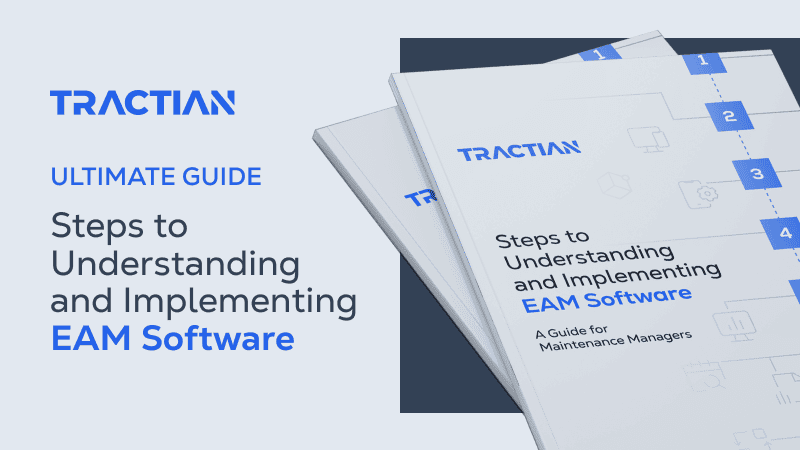Every minute of downtime chips away at your margins. For plants running 24/7, these aren’t simple maintenance issues, they’re also lost revenue, delayed orders, and pressure from every direction.
Because the stakes are so high, traditional maintenance strategies just can’t keep up with today’s operational demands. The needs are complex and time-constrained, causing preventive schedules to age fast and reactive fixes to come too late.
However, as is commonplace these days, evolving technology has a solution. One of these is predictive monitoring.
Predictive monitoring is a shift in how industrial teams tackle reliability. It uses real-time data and AI-powered algorithms to identify signs of failure before they break.
It equips maintenance managers and engineers with the insights they need to take control and stay ahead of failures. Early detection, fewer surprises, and actionable insights directly impact operational workflows and the bottom line by reducing cost without cutting corners.
In this article, we’ll explain how predictive monitoring works and what it takes to implement it.
What Is Predictive Monitoring?
Predictive monitoring is a data-driven approach that allows maintenance teams to detect anomalies and degradation in equipment before failure occurs.
It reduces downtime, improves reliability, and cuts costs by making maintenance actions proactive rather than reactive.
The concept revolves around continuously monitoring asset performance using IoT sensors that track parameters like vibration, temperature, current, or pressure.
These signals are processed using machine learning algorithms that understand how each asset behaves under normal conditions and identify when that behavior changes.
Predictive monitoring identifies the trend that indicates a potential failure is forming.
This foresight gives maintenance teams the time and context needed to act strategically and plan repairs during scheduled windows.
How Does Predictive Monitoring Help Process Manufacturing Plants?
Process manufacturing relies on consistency. A single deviation-whether in temperature, flow rate, or motor speed-can affect equipment performance, product quality, and yield.
Predictive monitoring allows teams to catch these deviations early, before they turn into costly failures or off-spec batches.
This means maintenance teams can step in at the right time, with the right fix, and avoid shutdowns altogether.
With early anomaly detection, production managers and engineers can also schedule interventions during planned stops, prioritize critical assets, and minimize disruption across the line.
This leads to higher uptime, better quality control, and more predictable output.
Predictive Vs. Preventive Maintenance
Preventive maintenance and predictive maintenance are both proactive. Yet, there are significant differences between them. The impact of these are demonstrated in methodology, workflows, and downstream effects.
Preventive maintenance follows a fixed schedule. Tasks are performed at regular intervals, regardless of the equipment's actual condition.
To this day, it’s the most well-known maintenance strategy in many industries, such as food and manufacturing.
However, though this approach reduces the risk of unexpected failure when compared to reactive maintenance, it still exhibits inefficiencies that our current technology has rendered unnecessary. For example, parts may be replaced too early, or problems might be missed because they weren’t monitored, resulting in failures before scheduled fixes.
Predictive maintenance changes the approach by relying on real-time data. It tracks asset health continuously and uses historical patterns to forecast failures. Maintenance is only performed when needed, based on how the equipment performs.
This difference improves resource allocation. Maintenance teams reduce unnecessary interventions, focus on the most critical assets, and respond to actual risks.
How Predictive Maintenance Works
Implementing predictive maintenance is a structured process that connects asset data to real-time decision-making.
Each stage below, from equipment selection to performance analysis, plays a specific role in making the system effective and scalable.
Equipment Selection And Sensor Installation
The first step is selecting the right equipment to monitor. Not every asset needs the same level of attention.
Start with critical machines-those that directly impact production throughput or carry high repair costs. When protected by predictive systems, these assets offer the highest return. Learn how to identify the most critical assets here.
Once identified, sensors are installed to track key indicators like vibration, temperature, current, or pressure. The choice of sensor depends on the failure modes you’re targeting.
Vibration is essential for rotating equipment. For motors, current and temperature can provide better insights. Installation should also take into account sensor placement and data fidelity, as poor positioning may lead to noise or missed events.
Data Collection And Transmission
Once the sensors are in place, the next step is capturing and transmitting data from each asset.
This includes continuous readings on vibration, temperature, energy consumption, and other performance indicators that reflect real operating conditions. The collected data is sent via wireless or wired networks to a centralized system for storage and processing.
To ensure consistency and reliability, the system must handle high-frequency sampling without bottlenecks.
This is especially important for detecting early-stage anomalies that standard interval-based logging would miss. Reliable data collection creates the real-time visibility that predictive maintenance depends on.
Data Processing And Analysis
Raw sensor data doesn’t create value on its own. It needs to be processed, filtered, and interpreted to reveal patterns.
This step transforms continuous data streams into usable insights by applying algorithms that detect trends, anomalies, and correlations.
The system compares current readings against historical baselines for each asset. It detects deviations that indicate early signs of wear or performance degradation-well before they reach a failure threshold.
This level of analysis requires accurate historical records and context-aware processing.
This phase includes noise reduction, signal normalization, and trend recognition. The goal is to remove the clutter and extract the signals that matter, giving maintenance teams the right information without overwhelming them with irrelevant alerts.
Predictive Modeling
Predictive modeling is where the system starts making forecasts based on asset behavior.
Using machine learning algorithms, it learns how each component typically performs and identifies deviations that indicate potential failure.
These models are built using both historical and real-time data. They analyze variables like vibration amplitude, temperature curves, and load cycles to create patterns that define what “normal” looks like for each asset.
When a data point diverges from this pattern, the system flags it as a risk.
The accuracy of these models improves over time as more data is processed, which is why consistent operation and data quality are key.
A well-trained model becomes a reliable decision-support tool that helps teams act before issues escalate.
Alert Generation and Maintenance Planning
The system generates a targeted alert once a predictive model detects a potential failure pattern.
But unlike generic alarms, these alerts include the specific context of what’s happening, where it’s occurring, and what it could lead to if ignored.
This is the turning point between insight and action. With clear, data-backed alerts, maintenance teams can prioritize tasks based on actual asset risk rather than guesswork or rigid schedules with no visibility.
Planners can align interventions with production cycles, minimizing disruption and avoiding emergency downtime.
At this stage, the platform becomes a strategic tool. It supports intelligent decisions about when to act, what parts to prepare, and how to coordinate teams.
Maintenance Execution
With a plan in place, the focus shifts to execution.
Technicians receive clear instructions supported by the system’s insights: what needs to be fixed, why, and with what urgency. This reduces troubleshooting time and ensures the right action is taken on the first visit.
Parts can be pre-ordered, downtime windows can be scheduled in advance, and labor is used more efficiently.
The result is a streamlined workflow where interventions are quicker, more precise, and less disruptive.
Performance Analysis And Model Adjustment
After maintenance is completed, the system continues tracking the asset to confirm whether performance has stabilized.
This step validates the intervention and helps refine future predictions. If the anomaly disappears, it confirms that the root cause was addressed correctly.
The feedback loop also improves the predictive models. By comparing expected outcomes with actual results, the system adjusts its algorithms to become more accurate over time.
Predictive Maintenance Technologies And Methods
No single method captures the full picture of an asset’s health. That’s why predictive maintenance uses a range of technologies, each targeting specific failure modes. The right mix depends on the type of equipment, its criticality, and how it fails.
Each technique provides unique insights, from mechanical wear to electrical issues and lubrication problems.
Vibration Analysis
Vibration analysis is one of the most widely used techniques in predictive maintenance, especially for rotating equipment like motors, pumps, and gearboxes.
It detects mechanical issues such as imbalance, misalignment, looseness, and bearing wear. Sensors capture vibration signals and convert them into frequency data. These frequencies reveal patterns that are tied to specific failure modes.
For example, a spike at a certain frequency might indicate an unbalanced rotor, while another may suggest bearing damage.
Motor Circuit Analysis
Motor circuit analysis (MCA) focuses on the electrical health of motors.
It identifies issues like insulation breakdown, winding faults, and imbalances in the electrical supply-problems that often go undetected until they cause major failures.
Unlike traditional megohm or continuity tests, MCA evaluates the motor as an integrated system.
It analyzes impedance, inductance, phase balance, and resistance without dismantling the equipment. Depending on the situation, testing can be done online or offline.
This method is especially valuable in facilities where motor reliability is critical. Detecting electrical degradation early prevents unplanned shutdowns, avoids energy waste, and helps extend motor lifespan through timely, targeted interventions.
Oil Analysis
Oil analysis evaluates the condition of both the lubricant and the equipment it serves.
It detects contamination, wear particles, and chemical degradation, providing insight into machine health and internal component wear without disassembly.
By sampling and analyzing the oil, teams can identify metal particles from gears or bearings, detect water or coolant ingress, and monitor additive depletion.
These indicators reveal problems like friction, overheating, or seal failures long before they escalate.
Regular oil analysis also acts as an early warning system for hidden mechanical issues, making it a key tool in predictive strategies for gearboxes, compressors, and hydraulic systems.
Thermography
Thermography uses infrared imaging to detect heat patterns on equipment surfaces.
It reveals temperature anomalies that indicate potential issues such as electrical imbalances, overloaded circuits, failing bearings, or misaligned components.
By capturing thermal images, teams can quickly identify hot spots without stopping the machine.
These visual readings make it easy to locate problem areas in panels, motors, pumps, and rotating equipment, especially where heat is an early sign of failure.
Thermal inspections are non-invasive, fast, and effective for monitoring both mechanical and electrical systems.
When used regularly, thermography supports safer operations and reduces the risk of fire or catastrophic failure.
Acoustics
Acoustic monitoring focuses on sound behavior in equipment to detect irregularities that may indicate failure.
It offers insight into conditions like cavitation, friction, or airflow restrictions by capturing sound waves produced by mechanical components in operation
Unlike vibration analysis, which focuses on frequency and amplitude, acoustic techniques target audible and ultrasonic signals that can reflect issues in valves, compressors, and hydraulic systems. Subtle changes in sound often precede more obvious mechanical failures.
This method is particularly effective in noisy environments where other diagnostics might struggle.
Ultrasonic Analysis
Ultrasonic analysis detects high-frequency sounds that are beyond the range of human hearing.
These signals often come from friction, turbulence, or electrical discharges, making this method ideal for identifying early-stage issues in mechanical and electrical systems.
Common applications include detecting bearing failures, compressed air or gas leaks, steam trap malfunctions, and electrical arcing.
Since ultrasound travels through air and structure, technicians can pinpoint problems with handheld devices or installed sensors, even in noisy or hard-to-reach areas.
The key advantage of ultrasonic analysis is its sensitivity. It picks up problems long before they become visible or audible.
Emissions Testing
Emissions testing evaluates the gases emitted by combustion engines and industrial processes to assess efficiency, compliance, and potential mechanical issues.
It’s especially relevant in environments where environmental regulations and fuel performance are closely monitored.
By analyzing exhaust gases-such as carbon monoxide, nitrogen oxides, and unburned hydrocarbons-technicians can identify problems such as incomplete combustion, worn engine components, or faulty sensors.
These conditions often signal deeper operational inefficiencies or upcoming failures.
Beyond compliance, emissions testing helps optimize fuel usage, extend equipment life, and maintain consistent process performance.
When integrated into predictive maintenance routines, it adds another layer of insight into the health of critical combustion-based assets.
Infrared Analysis
Infrared analysis focuses on identifying heat radiation across equipment surfaces, similar to thermography, but with greater emphasis on detailed spectral data.
It’s often used in material inspections, insulation assessments, and process monitoring.
This method captures subtle temperature variations that standard thermography might miss, making it useful in applications like refractory lining evaluations, process heater efficiency checks, and heat exchanger inspections.
It helps detect insulation breakdown, blockages, and inefficiencies in heat flow.
8 Benefits Of Predictive Monitoring
Predictive monitoring is a long-term operational strategy that improves performance across the entire plant. Let’s take a closer look at how it benefits industrial operations:
1. Decreased Downtime
Unplanned downtime is one of the most expensive risks in manufacturing.
Predictive monitoring tackles it head-on by identifying failure patterns before breakdowns occur. The system alerts teams early, giving them time to act without disrupting production schedules.
By catching issues while they’re still minor, technicians can intervene during planned stops or low-load periods. This shift from reactive to proactive drastically reduces the frequency and impact of unexpected shutdowns.
2. Cost Efficiency
Predictive monitoring helps reduce both direct and indirect maintenance costs.
By identifying issues early, it limits the need for emergency repairs, overtime labor, and expedited parts ordering-all of which drive up maintenance expenses.
It also minimizes unnecessary interventions. Instead of replacing components on a fixed schedule, teams can act only when performance data indicates a real need.
This extends the usable life of parts and avoids wasting resources on low-priority tasks.
3. Equipment Longevity
The earlier a problem is detected, the less damage it causes, and the longer the asset lasts.
Predictive monitoring supports this by continuously tracking stress, wear, and performance shifts across equipment. By maintaining assets within optimal operating conditions, you reduce the mechanical strain that shortens lifespan.
Small corrections, like addressing a misalignment or lubrication issue, can prevent cumulative damage that leads to early failure.
4. Operational Reliability
Predictive monitoring increases reliability by removing the guesswork from decisions. With real-time data and early warnings, teams can address potential failures before they escalate, keeping processes stable and consistent.
This stability translates into fewer interruptions, smoother production cycles, and stronger coordination between maintenance and operations.
Equipment runs within safe parameters, and unplanned interventions become rare exceptions and not the norm.
5. Safety Enhancement
Equipment failures stop production and create serious safety risks. Overheating motors, high-pressure leaks, and electrical faults can escalate quickly without early detection.
Predictive monitoring helps prevent these situations by identifying abnormal behavior before it becomes hazardous. By reducing the chances of unexpected breakdowns, teams are exposed to fewer high-risk scenarios.
Maintenance can be scheduled under controlled conditions, minimizing exposure to live systems or emergency repairs.
Ultimately, this protects technicians and operators, supports compliance with safety standards, and reduces the likelihood of incident-related downtime or penalties.
6. Production Optimization
When equipment runs consistently and reliably, production becomes easier to control and scale.
Predictive monitoring ensures that assets operate within ideal parameters, reducing performance dips that slow output or affect product quality. This allows planners to optimize workflows with fewer buffers or contingencies and leads to more efficient use of time, labor, and resources.
Predictive monitoring helps plants consistently hit production targets with less waste, higher uptime, and fewer process deviations.
7. Strategic Asset Management
With accurate insights into asset condition, teams can prioritize repairs, schedule replacements, and allocate resources based on real risk, not assumptions.
This visibility supports long-term planning. Instead of reacting to failures, you can confidently plan capital investments, adjust maintenance strategies, and extend asset life.
It also helps justify budgets and align maintenance goals with overall business performance.
8. Inventory Reduction
Predictive monitoring brings precision to spare parts management.
By knowing exactly when components will likely fail, teams can avoid overstocking and reduce the need for emergency inventory.
This shift lowers holding costs and minimizes the capital tied up in unused parts.
Instead of stocking “just in case”, inventory can be aligned with actual asset needs based on real-time condition data and failure predictions.
It also improves purchasing decisions. With better forecasting, procurement can be more strategic, ordering the right parts at the right time with less waste.

How Predictive Monitoring Can Help Your Industry
Predictive monitoring reshapes how plants manage reliability, regardless of sector, whether food and beverage, automotive, heavy industry, or energy.
It replaces guesswork with precision, breaks the cycle of reactive maintenance, and builds a foundation for smarter, more resilient operations.
The impact scales across the business. Production runs smoother. Technicians operate with clarity, not urgency. Costs go down, uptime goes up, and decision-making becomes rooted in data.
What once felt unpredictable now becomes manageable, measurable, and aligned with business performance.
For organizations looking to transform their maintenance operations from a cost center to a strategic asset, predictive monitoring is an essential, non-negotiable step.
If failures still dictate your maintenance schedule, it’s time to switch from reacting to predicting. Learn more about Tractian's predictive monitoring solution.



